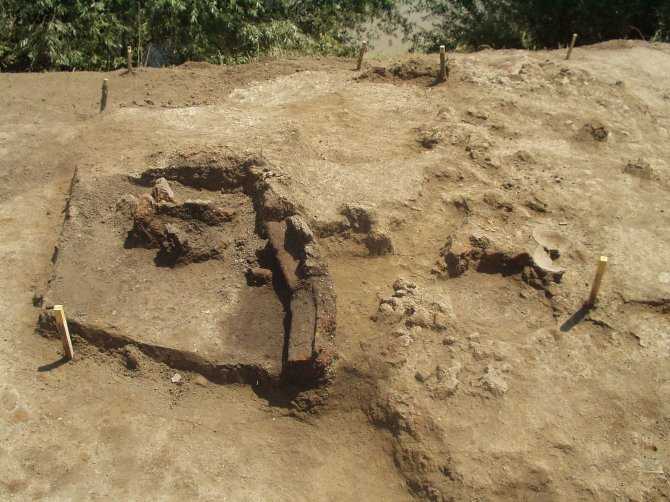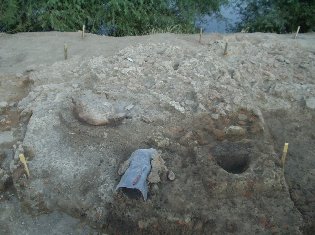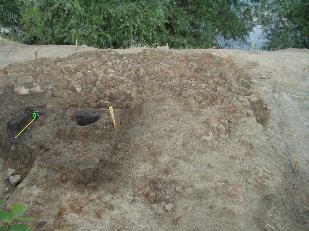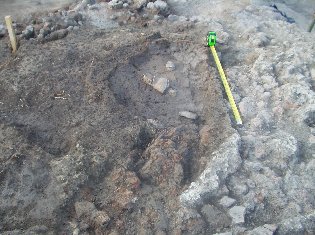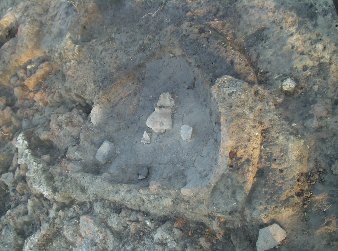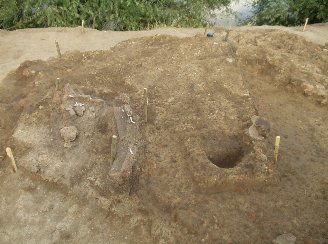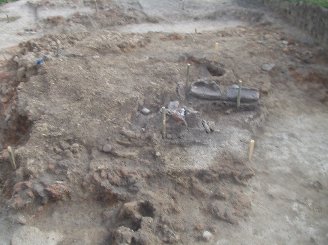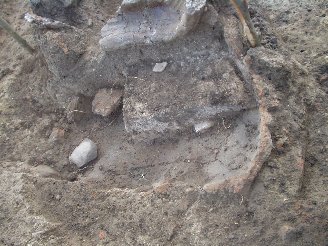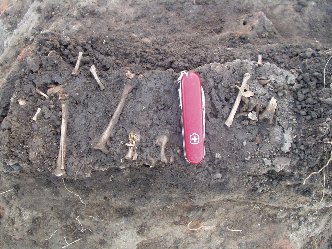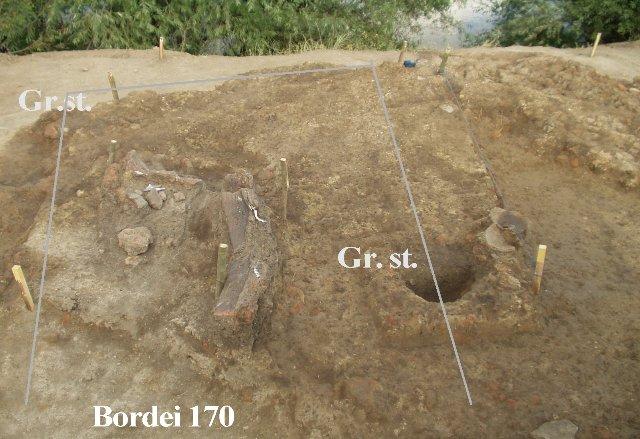

The Middle Age dwellings consist of pit houses, as mentioned in the first investigations made (Lazarovici et alii 2001, p. 119, fig. 155-160). All pit houses have 1-2 ovens dig in the wall, with a very well made fireplace. The Middle Age pit house (B 170.1) The Middle Age pit house (no. of the complex is Parta B 170.1) was excavated in the level of the Copper Age period (Tiszapolgár culture) and in the last Neolithic one (level 5, Banat IIIA culture), cutting the floor of a Neolithic house, located between P 49 and P 150 (now named as B 170.2). We cannot specify the exact dimensions of the pit house, because in the filling there is a ritual deposit, a cereal box (maybe belonging to this pit house; it was located on the edge of the complex, or in an annex of it). On the edge of the pit, a very large posthole was discovered, representative of how monumental the construction was. Other two symmetric postholes have been identified at the limit of the last filling. On the basis of the black soil of the filling, we can estimate that the pit house was 2.2 x 2.3 m. at its bottom.
The cereal box has a frame (10 cm high). Both have been installed on a wooden structure, maybe suspended. The cereal box was intentionally burned, although not very much, especially in the interior; therefore, we do not exclude the hypothesis that on occasions it might have been used for heating, in parallel with the oven, if both were located in the same room. Because the area was tremendously destroyed, now it is difficult to clarify the exact circumstances. The Middle Age oven (fig. 8) The Middle Age oven was excavated in the wall of the pit house, as in other identical complexes (Lazarovici et alii 2001 fig. 155-156, 158, 160); one part of the oven was under the floor of the house belonging to level 5. The vault of the oven has fallen down and in the filling we have even discovered Neolithic sherds. In the ashes from the bottom of the pit house we have discovered two Middle Age sherds, decorated with wave bands. Some moles have destroyed the fireplace of the oven. The fireplace was 5-6 cm lower than its bottom; this explains the ashes strata (6-7 cm) from the oven (fig. 8a).
Because the fireplace has not traces of reconstruction, we believe that the pit house has not been used for a long period of time. Being constructed on adobes strata, the fireplace ovens did not need a sherds base, as in the case of the Middle Age pit house L111. This last complex was deeper; it had a wooden structure that protected the borders, as in the Dacic pit houses (excavations Gh. Lazarovici – Tatár Árpad, Valea Mileului, Taga 2004). The construction of the oven in the wall of the pit house is a current practice noticed in different places such as Comana (Glodariu I., Costea Fl., Ciupea I., 1980, p. 84, in the pit house 19 and the semi – subterranean house 9), Ilidia - Funii (Teicu D., 2003, fig. 3, 6, p. 18, 21) and especially at Gornea (Uzum I. – Lazarovici Gh., 1974; Teicu D. – Lazarovici Gh., 1996, p. 19, fig. 4, 6, 8). Cereals box It is the first construction of this type in the Middle Age complex at Parţa. It was made of black earth mixed with clay and organic material (probably grass, not straw). Such cassettes (made by better clay mixed with straw, very well fired) have been found inside Neolithic houses (fixed on the floor or on the suspended floor). The Middle Age box was quadrilateral (1.2 x 1.3 m), with a rounded rim. In its filling a bitronconic Middle Age spindle whorl was discovered.
Middle Age ritual deposition Some thin bones (4 - 7 cm), maybe related with a cult deposition, have been found only under the long side of the cassette. In 2005 we have investigated rooms C (on the West) and D (on the East; both on the north side of the complex of houses) and another central space, E (in the middle, were on the west side it was the mention deer had). Room C and partially M. Moga’s excavations from 1943/1945 that cut the western part of the complexes have disturbed B. Andrei Fota, after an on the spot impregnation treatment, removed the box to Timişoara, at the Banat Museum. In other Middle Age pit houses (century VII/VIII), ritual deposits have been found, such as Iclod (a rabbit skeleton was found; we do not exclude that the rabbit might have died in this pit used as his burrow/den). Pit house B 170 at Parţa was cca. 4-5 m far from pit house B 110, Early Middle Age (Lazarovici et alii. 2001, p. 75 and 192). We have to remember that the grinder, the grinding stone and the cereal box are between the most important sacred items, for which communities have a special care. In many cases, the grinding stone is related with the cult of building or destroying the house, sacred deposition related with sacral numbers (3, 4, 6+1 or 7 at Balta Sărăta: Lazarovici, Gh., Petrescu S., 2003, fig. 12, 13, 16-18, 32-33), sacred offerings of the seeds in the sanctuary or sacred grinding (Lazarovici et alii, 2001, p. 224 a. s. o; Lazarovici 2003 and the bibliography of the problem).
|
|||||||||||||||||||||||||
